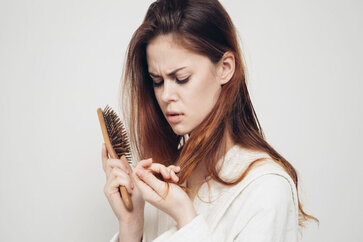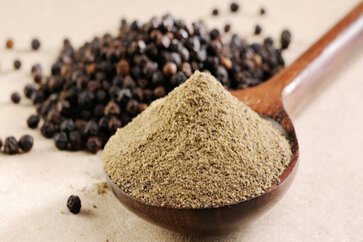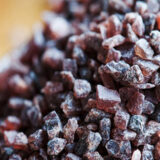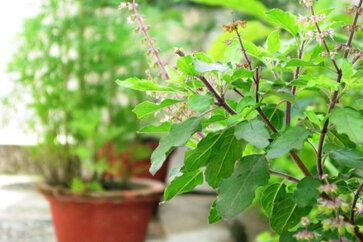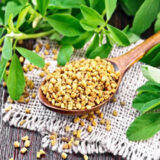Best Ayurvedic Treatment For Alopecia Areata
Alopecia is a term used to describe hair loss, which can occur due to various factors and conditions. It is not a specific condition itself but rather a symptom of underlying causes. 
The most common types of alopecia include alopecia areata, androgenetic alopecia (male or female pattern baldness), traction alopecia, telogen effluvium, cicatricial alopecia (scarring alopecia), and trichotillomania.
Alopecia areata is an autoimmune disorder where the immune system mistakenly attacks the hair follicles, resulting in patchy hair loss. Androgenetic alopecia is influenced by genetics and hormones, leading to gradual hair thinning or balding.
Traction alopecia occurs due to prolonged tension or pulling on the hair, often caused by certain hairstyles. Telogen effluvium involves temporary hair shedding due to physical or emotional stress.
Cicatricial alopecia involves permanent hair loss due to the destruction of hair follicles and replacement with scar tissue. Trichotillomania is a psychological disorder characterized by compulsive hair pulling.
What Is Alopecia?
Alopecia is a medical term that refers to hair loss. It is not a specific condition itself but rather a symptom of various underlying causes. The most common types of alopecia include:
1. Alopecia areata: This is an autoimmune disorder in which the immune system mistakenly attacks the hair follicles, resulting in patchy hair loss. It can occur on the scalp or other areas of the body.
2. Androgenetic alopecia: Also known as male or female pattern baldness, this type of alopecia is influenced by genetics and hormones. It typically leads to gradual hair thinning or balding in a predictable pattern, such as receding hairline in men or thinning crown in women.
3. Traction alopecia: This type of hair loss occurs due to prolonged tension or pulling on the hair, often caused by hairstyles that pull the hair tightly, such as braids, ponytails, or extensions. It is common among individuals who consistently wear such hairstyles.
4. Telogen effluvium: This condition involves temporary hair shedding caused by significant physical or emotional stress, hormonal changes, certain medications, or underlying medical conditions. The hair follicles enter a resting phase, leading to increased hair loss.
5. Cicatricial alopecia: Also known as scarring alopecia, this type involves permanent hair loss due to the destruction of hair follicles and their replacement with scar tissue. It can be caused by various conditions, including autoimmune diseases, infections, or inflammatory disorders.
6. Trichotillomania: This is a psychological disorder characterized by the irresistible urge to pull out one’s hair, leading to hair loss and noticeable patches of baldness.
Treatment options for alopecia depend on the underlying cause and can include medications, topical treatments, hair transplant surgery, or addressing any underlying medical conditions. It is advisable to consult with a healthcare professional for an accurate diagnosis and appropriate management of alopecia.
The exact causes of alopecia, or hair loss, are not fully understood. The process of follicles ceasing to produce visible hair and the sudden appearance of smooth bald patches remains a mystery. Currently, there is no diagnostic test available to predict the onset of alopecia.
Causes Of Alopecia
There are many factors that may contribute to hair loss below are some of them:
1. Ageing: As individuals age, hair growth may slow down and hair thinning or baldness can occur.
2. Genetic factors: Hereditary factors play a role in approximately 20% of hair loss cases.
3. Environmental factors: Exposure to certain environmental factors, such as pollutants or toxins, may contribute to hair loss.
4. Medications: Some medications, including those used in chemotherapy, can cause hair loss as a side effect.
5. Long-term illness: Serious illnesses or chronic conditions can sometimes result in hair loss.
6. Nutritional deficiency: Inadequate intake of essential nutrients, such as vitamins and minerals, can impact hair health and contribute to hair loss.
7. Thyroid dysfunction: Imbalances in thyroid hormone levels can affect hair growth and lead to hair loss.
8. Extreme stress: Physical or emotional stress can trigger hair loss or exacerbate existing hair loss conditions.
9. Exposure to chemicals: Prolonged exposure to certain chemicals or harsh hair products can damage the hair follicles and lead to hair loss.
10. Pregnancy: Hormonal changes during pregnancy can cause temporary hair loss, which usually resolves after childbirth.
11. Local skin disease: Certain skin conditions, such as scalp infections or autoimmune disorders, can result in hair loss.
12. Fungal infections: Infections of the scalp caused by fungi can lead to hair loss in affected areas.
13. Vaccines: In rare cases, certain vaccines have been associated with temporary hair loss as a side effect.
Note: It’s important to note that these factors may contribute to hair loss but may not be the sole cause in every individual case.
Consulting with a healthcare professional can help determine the underlying cause of alopecia and guide appropriate treatment options.
Symptoms Of Alopecia
The symptoms of alopecia can vary depending on the specific type of hair loss. Here are some common symptoms associated with different forms of alopecia:
1. Male pattern hair loss: Men with this type of alopecia typically experience thinning or complete hair loss at the hairline and the top of the head. It often begins with a receding hairline and can progress to a bald spot on the crown or complete baldness in severe cases.
2. Female diffuse hair loss: Women with this type of alopecia usually experience gradual hair loss, particularly on the top of the head. The hair thins out, and the scalp becomes more visible, but the hairline usually remains intact.
3. Alopecia areata: This form of alopecia is characterized by the presence of one or more round or oval patches of hair loss. The affected areas may have broken hair or hair that is easily pulled out. The patches can vary in size and may enlarge or merge over time.
If you notice any unusual hair loss or changes in your scalp, it is advisable to consult with a healthcare professional or a dermatologist for an accurate diagnosis and appropriate management.
Alopecia Areata Ayurvedic Treatment
Ayurveda offers various treatments to reduce hair loss and stimulate hair growth. Here are some Ayurvedic approaches commonly used:
1. Pitta Pacification: This treatment focuses on balancing the pitta dosha (one of the three doshas in Ayurveda) to enhance the digestive system. It involves following a pitta pacifying diet chart and taking Ayurvedic medications that help decrease pitta in the body. This therapy aims to remove toxins from the system using effective herbs.
2. Ayurvedic Oil Application: The use of medicated herbal hair oils, such as Jasminum grandiflorum oil, is highly effective in addressing baldness and promoting hair growth. These oils are applied to the scalp and hair to nourish the hair follicles and strengthen the hair.
3. Panchakarma Therapy: Panchakarma is a set of Ayurvedic therapies aimed at detoxifying and cleansing the body. It involves five methods to eliminate toxins and restore balance. Specific suggestions for panchakarma therapy in treating hair loss include Shirodhara, which is a head massage using medicated oils, and ksheera basti, a type of medicated enema.
4. Nasya: Nasya therapy involves the administration of Ayurvedic medications through the nasal cavity to eliminate impurities. This therapy is known to be effective in treating the signs of alopecia and promoting hair growth.
Ayurvedic Diet For Alopecia Areata
Ayurveda places great emphasis on the role of diet in promoting overall health and addressing specific health conditions, including alopecia. Here are some key principles of an Ayurvedic diet that can be beneficial for treating alopecia:
1. Balance the Doshas: According to Ayurveda, each individual has a unique constitution, or dosha, which consists of Vata, Pitta, and Kapha. Imbalances in these doshas can contribute to hair loss. An Ayurvedic diet aims to balance the doshas by including foods that help pacify the dominant dosha or doshas causing the imbalance.
2. Opt for Nourishing Foods: Focus on incorporating nourishing and wholesome foods into your diet. Include a variety of fresh fruits, vegetables, whole grains, legumes, and healthy fats. These foods provide essential nutrients like vitamins, minerals, and antioxidants that support hair health.
3. Stay Hydrated: Drink an adequate amount of water throughout the day to maintain hydration. Water helps in flushing out toxins and keeping the scalp and hair follicles healthy.
4. Include Herbal Teas: Certain herbal teas can be beneficial for hair health. For example, drinking herbal teas like amla (Indian gooseberry), brahmi (gotu kola), or neem can provide nourishment to the hair and scalp.
5. Avoid Processed and Refined Foods: Minimize the consumption of processed and refined foods, as they often lack nutritional value and can contribute to inflammation in the body.
6. Mindful Eating: Practice mindful eating by paying attention to your body’s hunger and fullness cues. Avoid overeating or eating in a rushed manner, as it can disrupt digestion and nutrient absorption.
7. Avoid Triggering Foods: Some individuals may find that certain foods trigger or worsen their hair loss. These can vary from person to person, but common triggers include excessive intake of spicy, oily, or fried foods. Pay attention to how your body reacts to different foods and make adjustments accordingly.
Note: It’s important to note that individual dietary recommendations may vary based on an individual’s unique constitution and specific needs. Consulting with an Ayurvedic practitioner or healthcare professional can provide personalized guidance on an Ayurvedic diet tailored to your condition and overall health.
Dos And Don’ts Of Alopecia And Hair Loss
When dealing with alopecia and hair loss, certain dos and don’ts can help promote hair health and minimize further hair loss. Here are the recommended guidelines:
Dos:
1. Take sound sleep to support overall well-being and healthy hair growth.
2. Manage stress and anxiety, as excessive stress can contribute to hair loss.
3. Opt for a protein-rich diet, as proteins are essential for hair growth and strength.
4. Practice meditation and exercise regularly to promote circulation and reduce stress.
5. Gently massage the scalp to improve blood circulation and stimulate hair growth.
6. Include fresh vegetables, sprouts, legumes, and soy in your diet for their nutritional benefits.
7. Stay adequately hydrated by drinking plenty of water, as it helps flush out toxins from the body.
8. After washing your hair, gently rub the scalp to stimulate the sebaceous glands and improve blood circulation.
9. Consume fruits, leafy vegetables, and milk to nourish and strengthen the hair.
10. Consider using aloe vera as it can help heal the scalp and cleanse the pores.
11. Incorporate white sesame seeds into your diet, as they are known for their natural hair loss treatment properties.
Don’ts:
1. Avoid excessive use of hair dyes, hair dryers, and curling irons, as they can damage the hair.
2. Refrain from vigorously rubbing your hair, as it can lead to hair breakage and damage.
3. Reduce consumption of junk food and excess calories, as they can impact overall health and hair condition.
4. Limit or avoid the consumption of alcohol and beverages that may have a negative impact on hair health.
5. Avoid harsh shampoos and conditioners that can strip the hair of its natural oils and cause further damage.
6. Steer clear of spicy foods and bakery products, as they can potentially increase Pitta dosha and aggravate hair loss.
It’s important to note that these recommendations may vary depending on individual circumstances and underlying causes of hair loss. Consulting with a healthcare professional or an Ayurvedic practitioner can provide personalized guidance tailored to your specific needs and condition.

